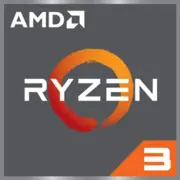AMD Ryzen 3 3250U

AMD Ryzen 3 3250U: Budget Processor for Everyday Tasks in 2025
(Analysis as of April 2025)
Introduction
The AMD Ryzen 3 3250U is a mobile processor designed for budget laptops. Although it is no longer new in 2025, it can still be found in entry-level ultrabooks priced between $400 and $600. This article explores who this chip is suitable for, how it handles modern tasks, and what to consider when purchasing.
Architecture and Process Technology
Key Specifications:
- Codename: Picasso
- Process Technology: 14 nm (the Picasso architecture is actually based on 12 nm, but specifications indicate 14 nm).
- Cores and Threads: 2 cores, 4 threads (thanks to SMT — Simultaneous Multithreading).
- Frequencies: Base clock — 2.6 GHz, maximum turbo clock — 3.5 GHz.
- Cache: L3 — 4 MB.
Architecture Features:
The chip is built on the Zen+ microarchitecture, which offers improved energy efficiency compared to the first-generation Zen. However, by 2025, the 14 nm process technology appears outdated compared to the 5 nm Apple M2 or 7 nm Ryzen 7000 series.
Integrated Graphics (iGPU):
- Model: AMD Radeon Vega 3.
- Compute Units: 3 CU (192 stream processors).
- Frequency: Up to 1200 MHz.
The graphics manage 4K video decoding and can run simple games, but they are insufficient for modern projects in 2025.
Power Consumption and TDP
- TDP: 15 W.
The processor is optimized for thin laptops with passive or compact active cooling. Due to its low thermal output, devices based on it remain quiet and do not overheat even under prolonged load.
Power-saving Technologies:
- Precision Boost 2: Automatically increases core frequencies depending on load and temperature.
- Cool’n’Quiet: Dynamically adjusts voltage and frequency to reduce power consumption during idle periods.
Real-world Performance
Office Work:
- Examples: Microsoft Office, a browser with 10+ tabs, Zoom.
- Results: The processor handles basic tasks, but launching several heavy applications simultaneously (e.g., Excel + Chrome + Slack) can cause slowdowns due to only having 2 cores.
Multimedia:
- Video: Smooth playback of 4K@60 FPS (thanks to VCN hardware decoding).
- Photo Editors: Light editing in Lightroom or Photoshop is possible, but rendering will take longer.
Gaming:
- Game Examples:
- CS:GO — 40–50 FPS on low settings (720p).
- Fortnite — 25–30 FPS (720p, minimum graphics).
- Stardew Valley and indie projects — stable 60 FPS.
For games in 2025, the Vega 3 is no longer suitable — even "light" projects like Hades II will have lag.
Turbo Mode:
During short bursts of load (e.g., opening an application), the frequency rises to 3.5 GHz, but with prolonged use (more than 5–10 minutes), due to the 15 W TDP, throttling occurs, and performance drops back to base values.
Usage Scenarios
Who is the Ryzen 3 3250U suitable for:
1. Students: Working with texts, presentations, online courses.
2. Office Workers: Email, documents, video conferencing.
3. Casual Users: Social media, streaming on YouTube, online shopping.
Who is it NOT suitable for:
- Gamers.
- Designers and video editors.
- Programmers using heavy IDEs or virtualization.
Battery Life
Battery Life:
- Under moderate load (web browser, office applications): 6–8 hours.
- In standby mode (music playback): up to 10 hours.
Factors Affecting Battery Life:
- Screen: Laptops with IPS displays and 250 nits brightness consume more power than models with TN screens.
- OS Optimization: Windows 11 in 2025 manages power consumption better than older versions.
Tip: For maximum battery life, choose models with at least a 50 Wh battery.
Comparison with Competitors
1. Intel Core i3-1115G4 (Tiger Lake, 10 nm):
- Pros: Higher single-thread performance (Geekbench 6 Single-Core — ~850), more modern Iris Xe graphics (48 EU).
- Cons: Laptops are priced $50–100 higher.
2. Apple M1 (5 nm):
- Pros: 3–4 times higher performance, 18 hours of battery life.
- Cons: Laptops with M1 start at $800, which is twice the price.
3. AMD Ryzen 5 5500U (Zen 2, 7 nm):
- Pros: 6 cores/12 threads, Vega 7 graphics.
- Cons: Laptops start at $600.
Conclusion: The Ryzen 3 3250U lags behind competitors in performance but wins in price.
Pros and Cons
Strengths:
- Low laptop pricing ($400–600).
- Sufficient performance for everyday tasks.
- Good energy efficiency.
Weaknesses:
- Only 2 cores — limited multitasking capability.
- Outdated 14 nm process technology.
- Weak iGPU for modern gaming.
Laptop Selection Recommendations
Device Type:
- Ultrabooks: ASUS Vivobook, Lenovo IdeaPad 3.
- Budget Chromebooks: For working with web applications.
What to Consider:
1. RAM: Minimum 8 GB (preferably 16 GB for Windows 11).
2. Storage: Only SSD (256 GB and above).
3. Screen: Full HD resolution — anything less than 1080p appears outdated in 2025.
Example Models:
- HP 15-dw2000: $450, 8 GB RAM, 256 GB SSD.
- Acer Aspire 3: $500, 16 GB RAM, IPS screen.
Final Conclusion
The AMD Ryzen 3 3250U is a processor for those seeking an affordable laptop for basic tasks. It suits:
- Students — for studying and Netflix.
- Office Workers — for document handling and Zoom.
- Senior Users — for ease of use.
Key Benefits:
- Low price.
- Compact design and quiet operation.
- Sufficient performance for 80% of everyday tasks.
If your budget allows for an additional $200, it’s better to choose a laptop with the Ryzen 5 5500U or Intel Core i5-1235U — they will last longer and won’t disappoint in multitasking.
Basic
CPU Specifications
Memory Specifications
GPU Specifications
Miscellaneous
Benchmarks
Compared to Other CPU
Share in social media
Or Link To Us
<a href="https://cputronic.com/en/cpu/amd-ryzen-3-3250u" target="_blank">AMD Ryzen 3 3250U</a>